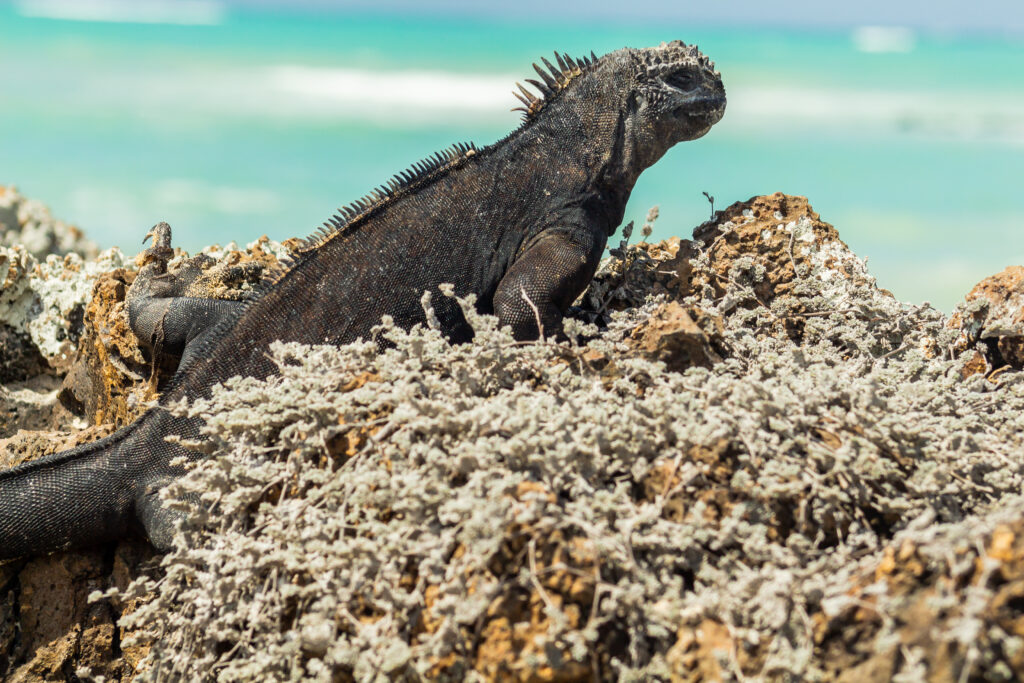AMAZING FACTS ABOUT THE Marine iguana
Introduction
Welcome, nature enthusiasts, to a captivating journey beneath the waves of the Galapagos Islands! Today, we embark on an adventure to uncover the secrets of one of the ocean’s most extraordinary inhabitants: the marine iguana.
From their ability to slow down their heart rates in frigid waters to their sneezing salt like seasoned chemists, these reptilian wonders have fascinated scientists and nature lovers alike for generations. Join us as we dive into the awe-inspiring world of marine iguanas and unlock the mysteries behind their unique adaptations.
Fact 1: Masters of evolution
The story of the marine iguana’s evolution begins on land. These iguanas likely descended from ancient iguana species that arrived on the islands millions of years ago. Over time, they faced the challenge of limited food resources on their volcanic homeland. To survive, they gradually evolved into marine specialists.
One of the key adaptations is their streamlined body shape, which allows them to swim efficiently. Their flattened tails act as rudders, while their long, sharp claws enable them to cling to rocks in turbulent coastal waters. However, the most astonishing adaptation is their ability to expel excess salt from specialized glands near their nostrils. This unique ability enables them to feed on marine algae without being overwhelmed by the high salt content.

Fact 2: Chameleon-like Color Adaptation of Marine Iguanas
Unlike many reptiles that rely on their coloration for camouflage, marine iguanas have evolved a distinctive and surprising adaptation. These extraordinary creatures are known to shift their color in response to their environment and physiological state.
When marine iguanas are cold or at rest, they often display a dark hue. This dark shade enables them to absorb more sunlight, assisting in quicker warming after their chilly ocean excursions. Conversely, when they are basking in the sun to regulate their body temperature or are in warmer surroundings, they can take on a lighter color. This shift in coloration not only aids in temperature management but also influences their overall appearance.
The ability to change color provides a fascinating glimpse into how marine iguanas have adapted to their unique environment in the Galápagos Islands. It underscores their impressive adaptability in responding to the challenges of their harsh coastal habitat and highlights the dynamic interplay between their biology and surroundings.
Fact 3: Marine Iguanas insane breath holding technique
These Galápagos residents have truly honed their underwater skills. When foraging, marine iguanas can descend to depths of up to 10 meters (33 feet) or even more, holding their breath for extended periods. This feat is made possible by a combination of physiological adaptations and their incredible ability to conserve oxygen.
Their bodies have evolved to efficiently store oxygen in their muscles and tissues, enabling them to stay submerged for up to 15 minutes at a time. They’ve also developed a specialized heart rate regulation system, which slows down during dives to conserve oxygen. Additionally, their efficient cold-blooded metabolism further aids in conserving energy during their underwater excursions.
Fact 4: Unique Breeding Style
In the challenging and competitive world of the Galápagos, marine iguanas have developed a distinctive strategy for reproduction. They typically undergo synchronous breeding, a remarkable phenomenon where the majority of females lay their eggs in a synchronized manner, often triggered by environmental cues.
This synchronization helps maximize the chances of survival for their offspring. It’s believed that this behavior evolved as an adaptation to the limited resources available on the islands. By laying their eggs at the same time, marine iguana hatchlings emerge en masse, overwhelming potential predators and increasing the likelihood that some will survive to maturity.
This unique reproductive strategy is a testament to the Galápagos marine iguana’s ability to adapt and thrive in one of the world’s most challenging and isolated environments. It highlights the intricate ways in which evolution has shaped their lives on these remote islands
Conclution
As we wrap up this thrilling adventure through the world of the Marine Iguana, we invite you to embark on your own exploration of the mesmerizing animal kingdom. Whether you’re passionate about big Lizards like the Marine Iguana, marine life, or creatures that inhabit the deepest corners of the rainforest, there’s always more to discover.
Take out your notebook and jot down the intriguing facts and stories that have piqued your interest. Dive into books, documentaries, and online resources that delve into the lives of various animals. Join local wildlife clubs or conservation groups to connect with like-minded enthusiasts and experts.

